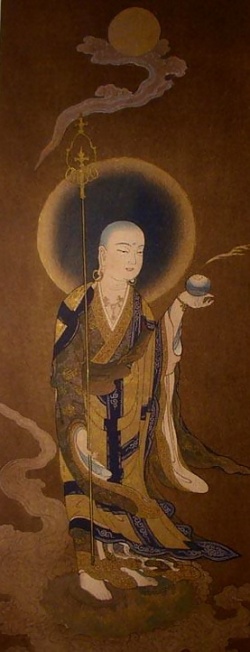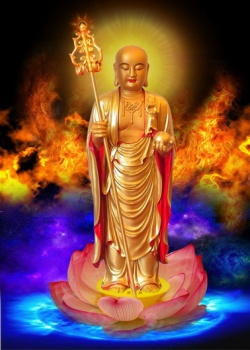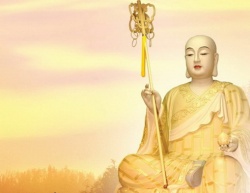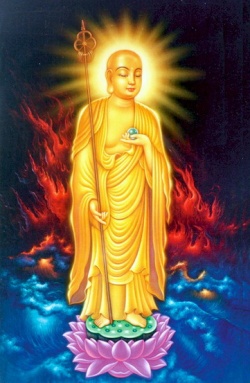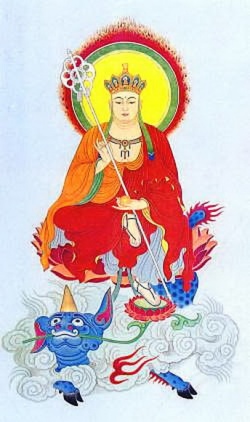Ksitigarbha Bodhisattva
- See also :
- See also :
Great Vow Bodhisattva
(Ksitigarbha Bodhisattva)
Ksitigarbha Bodhisattva is often referred to, because of his vow to not achieve Buddhahood until "all the Hells are empty", as the Bodhisattva of the Hell beings. But his vow actually encompasses all sentient beings, being similar to that of Living Buddha Lien-shen, who vows to reveal all the secrets of even the hidden teachings, in order to save sentient beings, even if he has to suffer retribution, even the pulverization of his bones and flesh.
Story of Earth Store Bodhisattva
Earth Store Bodhisattva is known as Ti Tsang (or Di Zang) Bodhisattva in China, Ksitigarbha in Sanskrit, and Jizo Bosatsu in Japan.
The name of this Bodhisattva means "the one who encompasses the earth". Earth means stillness, hardness, stability, vastness and versatility. It represents our mind which creates all dharma and accommodates all matters. It is the foundation on which everything grows, including the Buddhist Way. Store means deepness, profundity and subtleness. It represents the immeasurable treasures.
According to Earth Store Sutra, Earth Store Bodhisattva was appointed by Shakyamuni to be the headmaster of Buddhism on Earth during the period from the Nirvana of Shakyamuni to the advent of Maitreya, the next Buddha born on Earth. He is also said to be an incarnation of Enma (or Yama), the king of the Hell. In broader sense, he is the master of the Six Paths (i.e. Hell, Ghost, Animal, Man, Asura and Deva). Thus, he is described as occupying a position between deva/men and the hell for saving all beings from suffering. Undoubtedly, his status is well-respected by all Buddhas and other beings in the Ten Dharma Realms including human beings.
Earth Store Bodhisattva, one of the Four Great Bodhisattva in Buddhism, is the Bodhisattva with the greatest vow. His vow is:
If the Hell is not empty
I will not attain Buddhahood
As the Hell is the lowest in the Ten Dharma Realms, the vow implies that Earth Store Bodhisattva will be the last one to become Buddha amongst all.
Earth Store Bodhisattva is so compassionate that he renounces the states of Buddha, in order to rescue the beings from suffering and help them to attain enlightenment.
Earth Store Sutra describes the past life of Earth Store Bodhisattva. Before being a Bodhisattva, he was a young Indian girl of the Brahmin caste. Because her mother was impious, she was tortured and suffered in hell after she died. The young girl was terrified, thus made a great vow to save all beings from such torments.
As Earth Store Sutra was sermoned by Shakyamuni to his mother in Prayastrimsat, (not on Earth!) this Sutra is also known as the Sutra of filialipiety. If morality is the first step in cultivating Buddhist Way, filialipiety is the first step in morality. That is why this Sutra is so important for all Buddhist beginners.
The Earth Store Sutra also reveals the virtues and merits of Earth Store Bodhisattva and the method to cultivate the Buddhist Way. Therefore, the Sutra is one of the most popular sutras in Buddhism. People read and recite it as their daily practice in the cultivation of the Buddhist Way.
Like other Bodhisattva, Earth Store Bodhisattva is represented by many images and symbols, such as Six Ti-Tsang, Six Messengers, Yen Ming Ti-Tsang, etc. He always holds a piligrim staff and a cintamani (a disc of sun) surrounded by the ten kings of hell. It indicates that "He who delivers from the torments of hell."
Earth Store Bodhisattva is also well known in Japan, Korea and other countries. In Japan, he is the guardian of travellers by land, and he helps the women in labour. He also performs the role of a prolonger of life and guardian of safety of children. In Korea, he is also highly reputable as the object of worship.
Source
Ksitigarbha Bodhisattva
By Joe Hung, The China Post
Taoism adopts quite a number of Buddhist deities, including bodhisattvas. One best example of Buddhism-Taoism “confusion” is Ksitigarbha Bodhisattva (地藏王菩薩) known also as Fengdu da-di (酆都大地) or Great Emperor of Fengdu, who presides over the Hades. He is also known as Yanlo-wang (閻羅王), the king of Hell. Fengdu, incidentally, is a county in the province of Sichuan (四川), where a shockingly devastating earthquake hit on May 12, killing at least 50,000 people
Buddhists believe Hell is one of the six destinations in the reincarnation. Souls are punished in Hell for the wrongs people did in their previous reincarnations. Ksitigarbha vowed that as long as there was still one soul in Hell, he would not become a Buddha. As there are always souls being punished, he has never attained buddhahood. He is most commonly depicted as a monk with a five-sided crown, holding a lotus flower in his left hand and a mudra (gesture) of courage or a Buddhist staff in his right hand.
Ksitigarbha differed from other bodhisattvas in that he was never an enlightened Buddha in any of his previous incarnations. Maitreya, for instance, is a Buddha who stays in Tushita heaven awaiting a rebirth on earth to become the next Buddha after Gautama Siddhartha or the Tathagata (如來佛). In one of his incarnation, Ksitigarbha was a woman. When she made an offering to an arhat (羅漢) or one who can achieve nirvana anytime, the latter asked her if she had any wish. She said she would like to know where her deceased mother had gone. The arhat went into meditation. While in trance, the arhat sought and found her mother was in Hell, where her soul was being punished.
When he came out of the meditation, the old monk asked the woman why her mother should be suffering in Hell. “Mother loved to eat turtles, especially baby turtles,” she replied. Then the old man told her to recite the name of Amitabha (阿彌陀佛) or Namo Omituofo, which means “Hail, Amitarbha.” The arhat also drew a picture of Amitabha for her to worship. She did what she was told. Then she had a dream. Amitabha Buddha appeared in her dream and told her that her mother would be reborn in her own household.
The mother was reborn as a baby to a housemaid of the woman. The baby girl began to speak when it was only three days old. The baby told the woman she was indeed her mother in the previous life. “Thanks to your constant prayer,” the baby said, “I was able to leave Hell and was reborn in your household.” ‘But I can only live thirteen years,” the baby went on, “and I would go back to Hell.” That is the mother’s karma. She had not been punished enough for the wrongs she had done. The woman was very sad. She was sorry for her mother’s karma. Then she vowed to do what she could to help all sentient beings cease to suffer.
Source
Ksitigarbha Bodhisattva
Ksitigarbha Bodhisattva is often referred to as the Bodhisattva of the Hell beings because of his vow to not achieve Buddhahood until "all the Hells are empty". However, his vow actually encompasses all sentient beings, who vows to reveal all the secrets of even the hidden teachings, in order to save sentient beings, even if he has to suffer retribution, and the pulverization of his bones and flesh. His popularity among the Chinese and Japanese Buddhists is second only to Kuan Shih Yin P'usa as he takes upon himself the fearful and difficult task of bringing relief and consolation to the suffering beings of hell.
The birthday of Ksitigarbha Bodhisattva falls on the 30th day of the 7th moon of the Chinese lunar calendar. All over the world Buddhist temples offer prayers to Ti Tsang P'usa during the 7th lunar month for the benefit of the dead.
Ti Tsang is at times depicted accompanied by a dog, which also has a significant meaning. On the death of his mother, the Bodhisattva, not as "Sacred Girl', hastened into the underworld with the view of comforting her and to seek favorable treatment for her. However, he could not find her but later discovered that she had already taken rebirth as a female dog. Upon his return to earth Ti Tsang soon traced and adopted the animal, which then became his companion on his pilgrimages.
Om Pra Ma Ni Da Ni So Ha - Ksitigabha Bodhisattva Tibetan Mantra for Eradicating Fixed Karma.
Ksitigarbha Bodhisattva is found in many Buddhist homes and temples and he is seen seated upon a lotus throne. Wearing the robe of a Northern Buddhist monk and on his head is the "five-leave crown, where the representation of a Dhyani-Buddha can be seen on each of the leaves. He always has a benevolent and kind look carries either, or both, his symbols of the Cintamani or "Wish-fulfilling Jewel' and the "Ringed-Staff", which is also called the Khakkhara. This ringed staff is often carried by Buddhist monks in their travels so that the sounds caused by the jingling rings can warn small animals and insects of their approach lest they be trod upon and killed. It is also sometimes called the alarm-staff.
The Kshitigarbha bodhisattva has a deep relationship with beings of the earth – humans, and especially with the hungry ghosts and hell beings. This is mainly because these ghosts and hell beings are the most difficult to raise into a more fortunate condition due to their previous unwholesome actions. Thus Kshitigarbha has been known as the Teacher of the Dark Regions because of his past vow to save them all. The famous declaration "if I do not go to hell to help them, who else will go?" is popularly attributed to Kshitigarbha. He is willing to have a connection with any being, no matter what the crime or the karma and his aim is to help free them from suffering. He has many emanations and he has manifested in countless forms to save beings at different times and places. In the Chinese Buddhist Pantheon his is the only figure in the form of a monk. This is to indicate that Mahayana Buddhism is suitable for both the monks and the laity.
The Sutra is fundamentally a teaching concerning karma, graphically describing the consequences one creates by committing undesirable actions. This is especially for the benefit of future beings in the Dharma-Ending Age in order to help these beings avoid making the mistakes that will cause them to be reborn in a low condition. With this motivation, the sutra is a discourse given by the Buddha in praise of the Bodhisattva Kshitigarbha and his heroic Vow, and of the benefits one can receive from worshipping Kshitigarbha and by reading the sutra.
The bodhisattva appears in different transformations, depending on which realm he is in. Nevertheless, the most popular depiction of this bodhisattva in Chinese temples is as a monk with or without a five-sided crown. This appearance is quite extraordinary because other bodhisattvas tend to be portrayed as lay people with jewels and ornaments around their bodies and heads. The difference is that Ksitigarbha wants all people to respect the Three Treasures - the Buddha, the dharma and the sangha - and to believe in the law of cause and effect.
Ksitigarbha Bodhisattva was different from other bodhisattvas in that he was never an enlightened buddha in any of his previous incarnations. The Ksitigarbha Bodhisattva Sutra describes previous existences of the bodhisattva and explains what caused his previous incarnations to vow to carry out the Path of the Bodhisattvas.
In the first incarnation, the young bodhisattva saw a buddha one day, and he was awed by the Buddha's majestic appearance. His appearance stemmed from his abundant blessings, which in turn originated from his compassion. He asked the buddha how he could obtain such an exalted appearance and temperament, and the buddha replied, "You must help all suffering beings for generations to come." The young man then vowed to do so.
Presented in the form of a dialogue between the Buddha and Kshitigarbha, the teaching takes place in a certain heaven called Trayastrimsa, where the Buddha went so that he might repay the kindness of his mother who dwelt there by speaking the Dharma on her behalf. Hence, the sutra also deals with filial responsibility - not only that between oneself and one's parents, but also in an ultimate sense of a universal code of duty or responsibility for all living beings, all of whom a Bodhisattva regards with the same kindness, consideration and respect that one should accord to one's own parents.
Sakyamuni Buddha entrusted Ksitigarbha Bodhisattva the responsibility of continuing to save people after the Buddha himself passed away. During this period humans and other living beings have no buddha to guide them on the path to enlightenment until the next buddha, Maitreya, who will appear on earth several thousand years from now. Thus Sakyamuni Buddha entrust Ksitigarbha to shoulder the responsibility of relieving people from their worries and guiding them to enlightenment.
